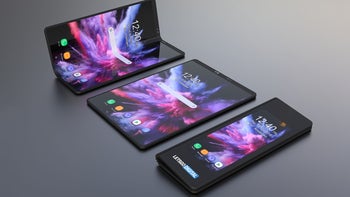The future of the smartphone is foldable, Samsung says

Concept design for a Samsung foldable phone by LetsGoDigital
Over the years since it was first teased, Samsung's foldable phone has become a bit of a joke, with many doubting that current consumer-grade tech is where it should be to deliver the company's ultimate vision. And seeing as how the device remained in prototype state for such a long time Samsung must have realized this full well. However, tech has progressed to the point where Samsung's R&D believes that foldability is the next big and logical step in designing mobile devices.
The company recently teased the foldable phone once again, hinting that it may have something to share at the Galaxy S10 'Unpacked' event next month. Ironically, while the happening is all about the next S-series flagship models, they may be among the last Samsung top-end phones with a 'traditional' design – that is, a rigid device that is bound to the size of its display.
In a recent editorial, Senior Vice President and Head of the Visual R&D Team at Samsung's mobile division Hark-sang Kim reveals that developing a new form factor that resolves the contradiction between screen size and portability has become the central focus of the company's innovation efforts.
"Despite current trends, we are still living in a world where the size of the smartphone display can only be as large as the device itself," writes Kim.

Samsung's official Galaxy S10 Unpacked event teaser has a 'fold' running down the middle. Could this be another hint at a surprise reveal?
We've discussed in the past how the notch is a stopgap on the way to the all-screen phone, but many analysts claim that achieving this vision will bring us to the limits of design innovation possible on the current form factor, leading to even smaller and more incremental updates between generations. Samsung is trying to think ahead and solve this issue by transitioning from a rigid construction to a flexible one.
We live in a world where the size of a smartphone display can only be as large as the device itself
The Infinity Flex Display was first revealed at SDC 2018 and signaled the start of a new chapter for the company, but prototypes of Samsung flexible displays have been publicly shown since as early as CES 2011. It took seven years for the technology to progress to the point where Samsung feels confident in the endeavor, though many would claim it's a bit early still."We expect to see a sea change in the smartphone form factor in the coming years. From rollable and stretchable devices to the devices that can fold in multiple ways are no longer beyond the realms of reality. Samsung is ready to usher in this future and create meaningful experiences for consumers that help them do more of what they love," Kim writes.
Among the biggest hurdles of designing a foldable phone is, well, the way it folds. Old prototypes, even though briefly showcased, were obviously too rigid and unnatural to interact with. The displays were also less than perfect, with prototypes from both Samsung and other companies exhibiting dead pixels and other problems with their screens, due to the panel having to bend in extreme fashions to facilitate for the design.
But that's only part of the struggle. The placements of the battery, cooling system, and camera also had to be rethought for the flexible form factor. Then there's the user interface and user experience, which vary more than you'd imagine when you're dealing with a device that can drastically change the size of its active screen area on the fly.

Seems like that old Samsung ad from 2013 that imagined what a foldable phone could be — silly as it may still be for other reasons — wasn't that far off in its depiction of a foldable smartphone. We just didn't know it would take 6 years for the technology to mature enough. And even if Samsung's foldable device really is the future of smartphones and launches this year, it would still take a generation or two for the new design to catch on and be embraced by the industry, if it ever does.
The foldable form factor would first have to prove itself a viable replacement to what we currently have. Samsung says the phone can withstand "hundreds of thousands of folds," but as with any emerging technology, the first generation is often a testing grounds for new ideas and it is very important how the stage is handled. This can make or break a new format, as we all know.
Whether the future is as bright as Samsung's R&D envisions — or rather, whether the technology is there for the vision to be achieved in the near future — is too early to say at this point. Rest assure, however, that we're going to be hearing a lot more about Samsung's foldable phone this year, if not even see it on store shelves in the first half.












Things that are NOT allowed: